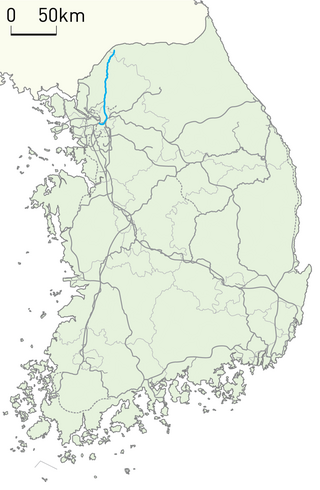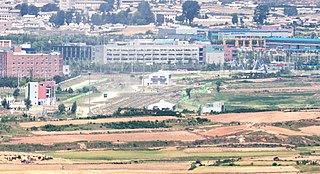
Shinkaichi Station is a railway station operated by Hanshin Electric Railway Co., Ltd., Hankyu Corporation and Kobe Electric Railway Co., Ltd. in the district of Shinkaichi, Hyogo-ku, Kobe opened on April 7, 1968.

The Gyeongwon Line is a railway line serving northeastern Gyeonggi Province in South Korea. The line is operated by Korail. The name of the line came from Gyeongseong (Seoul) and Wonsan, the original terminus of the line, in what is now North Korea.

Shimo-kitazawa Station is an interchange station on the Odakyu Odawara and the Keio Inokashira lines located in Kitazawa, Setagaya, Tokyo, and jointly operated by the private railway operators Odakyu Electric Railway and Keio Corporation.

The Donghae Bukbu Line is a former railway line that connected the present-day city of Anbyon in Kangwon Province, North Korea, with Yangyang, Gangwon Province, South Korea. Since the division of Korea it has only carried trains for a brief period during 2007/8. The line originally connected to the Gyeongwon Line running from Gyeongseong to Wonsan.

Hokkaidō-Iryōdaigaku Station is a railway station on the Sasshō Line in Tōbetsu, Hokkaidō, Japan, operated by the Hokkaido Railway Company. The station is numbered G14 and serves the Tōbetsu Campus of the Health Sciences University of Hokkaido (HSUH). Since the closure of the railway between Shin-Totsukawa and this station on May 7, 2020, it has been the northern terminus of the line.

Ikenotani Station is a junction passenger railway station located in the city of Naruto, Tokushima Prefecture, Japan. It is operated by JR Shikoku. It has two station numbers: "T04" for the Kōtoku Line and "N04" for the Naruto Line.

Hantangang Station was a railway station on the Gyeongwon Line in South Korea.

Woljeong-ri station is a closed railway station on the Gyeongwon Line in South Korea. It was closed by the Korean War. It is a noted place in the Korean Demilitarized Zone.

P'anmun station is a railway station located in the Kaesŏng Industrial Region, North Hwanghae province, North Korea. It is located on the P'yŏngbu Line, which was formed from part of the Kyŏngŭi Line to accommodate the shift of the capital from Seoul to P'yŏngyang.

The Fukui Railway Fukubu Line is a 21.4-kilometre (13.3 mi) railway line operated by Fukui Railway in Fukui Prefecture. The line runs from Takefu-shin Station in Echizen to Tawaramachi and Fukui-Ekimae stations in Fukui. Although it has its own right-of-way for most of the route, the Fukubu Line runs with traffic as a tram line past Fukui-Shin Station.

Ōbarino Station is a railway station in the city of Akita, Akita Prefecture, Japan, operated by East Japan Railway Company.
Kowŏn station is a railway station of the Korean State Railway in Kowŏn-ŭp, Kowŏn County, South Hamgyŏng, North Korea. It is the junction where the P'yŏngra Line, which connects P'yŏngyang to Rajin, meets the Kangwŏn Line running from Kowŏn to P'yŏnggang.
The Hamgyeong Line was a railway line of the Chosen Government Railway (Sentetsu) in Japanese-occupied Korea, running from Wonsan to Sangsambong. Construction began in 1914, and was completed in 1928. The line is now entirely within North Korea; the Korean State Railway has divided it between the Kangwŏn Line, the P'yŏngra Line, the Kangdŏk Line (Namgangdŏk−Suseong), and the Hambuk Line.
Ch'ŏngjin Ch'ŏngnyŏn station is the central railway station in Ch'ŏngjin-si, North Hamgyŏng Province, North Korea. It is the junction point of the Hambuk Line and the P'yŏngra Line of the Korean State Railway, and is the beginning of the Ch'ŏngjinhang Line to Ch'ŏngjin Port.
Hamhŭng station is a railway station in Yŏkchŏn 1-dong, Sŏngch'ŏngang-guyŏk, Hamhŭng city, South Hamgyŏng province, North Korea, located on the P'yŏngra Line of the Korean State Railway; it is also the starting point of the Sinhŭng Line and the Sŏho Line. A locomotive depot is located here, and there are spurs to the Hamhŭng Knitwear Factory and the Paekkŭmsan Combined Foodstuffs Factory in Haebit-tong, Sŏngch'ŏngang-guyŏk.

The Kangwŏn Line is a 145.8 km (90.6 mi) electrified standard-gauge trunk line of the Korean State Railway of North Korea, connecting Kowŏn on the P'yŏngra Line to P'yŏnggang, providing an east–west connection between the P'yŏngra and Ch'ŏngnyŏn Ich'ŏn lines.

The Toshiba DeRoI-class was a group of nine boxcab-style electric locomotives with regenerative braking and the capability for multiple-unit control manufactured by built by Toshiba in 1943-1944. They were very similar to the Mitsubishi-built DeRoI-class locomotives and the DeRoNi-class locomotives built by Hitachi. They were built for the Chosen Government Railway (Sentetsu), and after the partition of Korea were inherited by the Korean State Railway of North Korea, where they were known as the Chŏngiha class.
The Gyeongwon Line was a railway line of the Chosen Government Railway in central Korea. It was the first east-west trunk line to be opened, connecting the capital Gyeongseong to the important east coast port of Wonsan. Following the partition of Korea, the line was divided between North and South Korea.
The Donghae Bukbu Line was a railway line of the Chosen Government Railway (Sentetsu) in Korea connecting Anbyeon with Yangyang.

Shimabarakō Station is a train station located in Shimabara, Nagasaki Prefecture, Japan. It is on the Shimabara Railway Line which is operated by the third-sector Shimabara Railway.





















